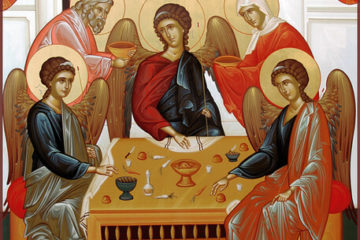The Incarnation was a cosmic event, in the sense that the stars bowed down to the Creator now part of the creation. All of creation rejoiced with the Creator in its midst.
Similarly, at the crucifixion, when the Creator was crucified by the creation, the sun and moon hid their light, and there was complete darkness over the whole earth. As the above hymn states, the creation that rejoiced at the Incarnation, now trembled at the Crucifixion. The foundations of the earth were shaken with earthquakes. The great lights went into hiding, mountains shook, and rocks split.
The Gospels are intentional in giving the time of the Crucifixion, that it occurred between the sixth and ninth hour of the day. In the Judaic (and now Byzantine) way of counting, the hours corresponded with the rising and setting of the sun. The first hour is the sunrise, the third hour is mid-morning, the sixth hour is midday, the ninth hour is mid-afternoon, and the twelfth hour is sunset. Thus, in the middle of the day until mid-afternoon, the whole of creation was in total darkness.
Before the creation of the world, there was nothing but darkness. The first thing God created was light. A new dawn of the world was about to happen with the Resurrection and before this triumph of Christ the True Light, the world was plunged again into darkness.
The first covenant of God was with Abraham. It was punctuated by the giving of the Law to Moses. The covenant was God’s promise to walk with His people. The Law was the order for how this was going to happen, how God would walk with the people, and how the people would walk with God. Part of the Law was the establishment of a temple, where the tablets of the Law, the Ten Commandments, the tangible symbol of the Old Covenant would reside. There were specific rules about who could go where and do what in the temple. For instance, the high priest could only go into the inner most area of the sanctuary once a year. The Holy of Holies was sealed off from the rest of the congregation with a curtain. When Jesus was crucified, the curtain of the temple was torn in two. After the Resurrection, the New Covenant, the Body and Blood of Christ, would be accessible to all. There would be no need of a curtain to separate the holy of holies from everyone.
In our liturgical practice today in the Orthodox Church, there are times when a curtain covers the altar. For instance, when there is no church, a door or curtain covers the altar. There are also times during some services, especially during Lent, when it is prescribed for the curtain to be closed. However, generally the curtain or door is open to the altar sanctuary during services, giving the congregation visual access to what is going on.
The Old Covenant was based on the Law, specifically 613 rules of conduct. The New Covenant is based on Christ, and there are only two rules, to love God and love our neighbor. The Old Covenant was based on the Law. The New Covenant is based on love. Day turned into night at the crucifixion, but the darkness (inadequacies) of the Law were about to give way to the light of the Resurrected Christ.
I approach You early in the morning, O Word of God, Who, through Your compassion for fallen man, emptied Yourself without change, and submitted to the Passion in impassivity. O Merciful Lord, grant me peace. (5th Ode, 12 Gospels, Holy Thursday Evening, Trans. by Fr. George Papadeas)
As the crucifixion was happening, God was preparing the world for the Resurrection, first by taking humanity back to the darkness that preceded the dawn of Creation, and secondly, by essentially destroying the Old Covenant so that the world would be ready for the New Covenant.

0 Comments